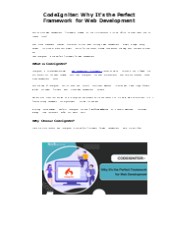QA For Web Sites: What Can Go Wrong - PowerPoint PPT Presentation
Title:
QA For Web Sites: What Can Go Wrong
Description:
A centre of expertise in digital information management www.ukoln.ac.uk. QA For Web Sites: ... analysing redirect message and not page. Tool analysing frame ... – PowerPoint PPT presentation
Number of Views:58
Avg rating:3.0/5.0
Title: QA For Web Sites: What Can Go Wrong
1
QA For Web SitesWhat Can Go Wrong?
http//www.ukoln.ac.uk/qa-focus/presentations/ili-
2004/
Talk 2
- Brian Kelly
- UKOLN
- University of Bath
- Bath
Email B.Kelly_at_ukoln.ac.uk
UKOLN is supported by
2
What Can Go Wrong?
Exercise
- In small groups
- Introduce yourselves
- Outline key areas in which things can go wrong on
your Web site - Group these into
- Mission-critical problems
- Significant problems
- Minor problems
- Summarise how you find out that things have gone
wrong - Choose a reporter to give a brief report back
Spend about 10 minutes on this exercise.
3
What Can Go Wrong?
Pages displayed incorrectly
Pages not displayed
Inaccessible Web site
Broken links
Backend systems don't work
Usability problems
Possible Problems
Forms don't work
People issues
Security problems
Workflow issues
Poor performance
Wrong functionality
Out-of-date content
Incorrect or misleading content
4
How Would You Find Out?
- How would you find out when things have gone
wrong? - Users inform you
- Users complain
- The boss of your organisation informs you
- You occasionally check things
- You have systematic procedures for checking
- Users report problems during system testing prior
to release of service
Finding Problems
5
Tools And Techniques
- We will now look at tools and techniques which
can be used for checking various aspects of Web
sites including - Compliance with HTML standards
- Compliance with CSS standards
- Compliance with accessibility guidelines
- Link checking
Finding Problems
6
HTML and CSS Validation
- Why?
- You should validate HTML pages to ensure that it
will work in multiple browsers, will be
accessible and is interoperable - Tools
- You can use desktop tools or Web-based services
(e.g. W3C)
Finding Problems
7
Checking Links
- Why?
- You should check the links on your pages to
ensure that your Web service is functional - Tools
- You can use desktop tools or Web-based services
(e.g. W3C)
Finding Problems
Note As well as traditional hyperlinks (and
images) Web pages may also have links to
JavaScript and CSS files. You will need to ensure
the links work otherwise the page may not be
usable.
8
Web-Checking Services
http//www.doctor-html.com/RxHTML/
- There are many Web-checking services which will
carry out multiple checks e.g. DrHTML,
NetMechanic,
Finding Problems
9
Limitations Of Tools
- When using these tools across many Web sites
sometimes unusual or unexpected findings occur - Obvious mistakes made (page size clearly too
small) - Tool uses out-of-date standard
- You should be aware of
- Tool analysing redirect message and not page
- Tool analysing frame set and not pages
- Tool not analysing embedded objects
- Tools may need to be complemented by manual
checking (e.g. accessibility, usability, content)
Finding Problems
10
Accompanying Resources
- About HTML Standards
- Compliance with HTML Standards, QA Focus,
Briefing Document No. 1 - Cascading Style Sheets (CSS)
- Use Of Cascading Style Sheets (CSS), QA Focus,
Briefing Document No. 34 - Link Checking
- Approaches To Link Checking, QA Focus, Briefing
Document No. 7































